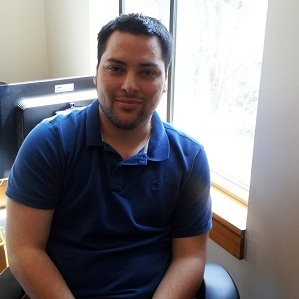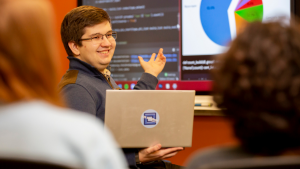Sam Diament was a tutor in the CIS Sandbox even before it first opened in Fall, 2011. He graduated from Bentley with his BS in Computer Information Systems, and MS IT, and is now an IT consultant at CoEnterprise. He returned to campus recently for the fall career fair, and wrote this post for the CIS Sandbox blog on the plane while travelling to his next consulting assignment.
For the CIS Sandbox Blog:
How Tutoring Prepared Me to Be an IT Consultant
By Sam Diament
 Good evening from a plane 10,000 feet above the sky en route to Louisville, Kentucky. I’ve heard good things about Louisville – at least everyone I’ve asked has said essentially the same thing. I’ve never been to Louisville before, and I’m excited about going somewhere for the first time. So, this should be fun.
Good evening from a plane 10,000 feet above the sky en route to Louisville, Kentucky. I’ve heard good things about Louisville – at least everyone I’ve asked has said essentially the same thing. I’ve never been to Louisville before, and I’m excited about going somewhere for the first time. So, this should be fun.
As I sit here and look at the window, I think to myself, “How did I end up here?” That may seem a little melodramatic; I’m not the first consultant traveling for work. And yet, there’s still this nervous excitement about packing up and traveling somewhere for a week. I should be over this by now – and I mostly am – but I still get some goosebumps when I’m boarding a plane.
To answer that question, it helps to understand what I do, and that depends on who asks me. On a date, I’m a technology consultant and I get to travel. At recruiting events, I’m a system engineer specializing in middleware and B2B solutions. To my grandmother, I work with computers.
So what do I actually do? I am a consultant. I work with computers and get to travel to various places to help customers solve the issue of transferring critical business documents electronically through a platform called IBM Sterling Commerce. But yeah, that sounds boring, so let’s go with the technology consultant one.
I started my job with CoEnterprise in June of 2013, a few months after finishing my masters program at Bentley University. I had no idea what to expect and I had never heard of Sterling Commerce before. The little experience I had included growing up with parents who spent their entire careers working in IT; knowing what the abbreviations “EDI” and “B2B” stood for; and, of course, tutoring.
Brief aside here to note some very important things about me: I’m very shy and introverted. Knowing that about myself, I decided to apply for a job on campus that would force me to work with other people. Brilliant, right? So I show up for work in the CIS Lab (back before it was called “The CIS Sandbox”) on my first day, and I sat there and waited. Then I did some homework, browsed the web a little, and went back to my dorm at the end of my shift. Seriously, I got paid to sit around and do what I would normally do in my dorm room. Sure, every once in a while a student would come and ask for help, and I obliged. But that was not the norm.
One day during one of my normal, eventless shifts in the Lab, Mark Frydenberg appeared and asked me a few questions. Namely, “How the heck am I supposed to know who is working right now?” among others. Then he told me he would be taking over the Lab and briefly presented to me his image for what he envisioned it would become. Long story short: it became that. That being not only what it is today and what Mark had envisioned originally but also much more.
The very first thing I had to learn in order to be a successful tutor was the ability to put myself in a student’s shoes. It is difficult to ask someone for help. It can be intimidating if the person you’re asking knows too much, and it’s almost always embarrassing. So, I had to force myself to become proactive. My standard greeting became, “Hi, how are you? What are we working on today?” It’s such a little thing but asking what “you are working on” is polarizing and highlights the fact that the student is here asking for help. Asking what “we are working” on means that we are working on this together. I may have more experience with the technology at hand, but we’re here to solve this problem together. Something even as small as using a collective pronoun helps build trust with your counterpart. I try to keep this in mind every time I write an e-mail to a customer today.
My next lesson was learning to say no. I distinctly remember having a shift that occurred right before the weekly advanced Java class, Mondays at 6:30 PM. Every week, on cue, several students would show up at 6:00 PM and ask me for help on the assignment that was due that night. Unfortunately, despite my best efforts, I was and still am unable to be in multiple places at once. And that meant that I had to say, “I’m sorry, I can’t help you” to some students. Today, I use my ability to say no when a customer asks me for a late change after we have already agreed to a set of requirements and a schedule. I’d love to be able to say yes to everything my customers ask me to do, but doing so increases the risk of the team not being able to finish the critical tasks that are necessary to the success of the project.
Here’s an interesting one: sometimes I wasn’t able to help the student. At times it was because I was not familiar with the subject being tutored. Other times the student and I just couldn’t get on the same page. In our consulting projects we always begin with a thorough requirements gathering process. Occasionally, at the end of this phase, either we or the customer decides that what we are offering just is not the right fit for them. That is not necessarily a reflection on our abilities; sometimes things just don’t work out. In that case it’s best to maintain a professional and courteous relationship because you never know how things might change in a few months or years.
Toward my latter years at the CIS Sandbox I began working as a Department Assistant, for which the responsibilities included creating the schedule each semester, dealing with resource/scheduling conflicts, and providing Mark with monthly reports. Have you ever tried creating a schedule while trying to balance the agenda of 15 college students and be as fair as possible (meaning I got stuck with the morning shifts)? It is difficult, stressful, and great preparation for creating schedules as a consultant.
I saved my most important lesson for last: take pride in your work. Sometimes I worked with students for 20 minutes and never saw them again. Other times, I would see the same student return to the lab and wait for me to be available. In both cases, I put all of my effort into performing my best work each time. I took personal pride in helping my students, and, to this day, I take personal pride in delivering a successful implementation to a customer.
Today, I want to ensure that when I finish an engagement with a customer, they will not only have a working system but also feel empowered to be able to support that solution.



